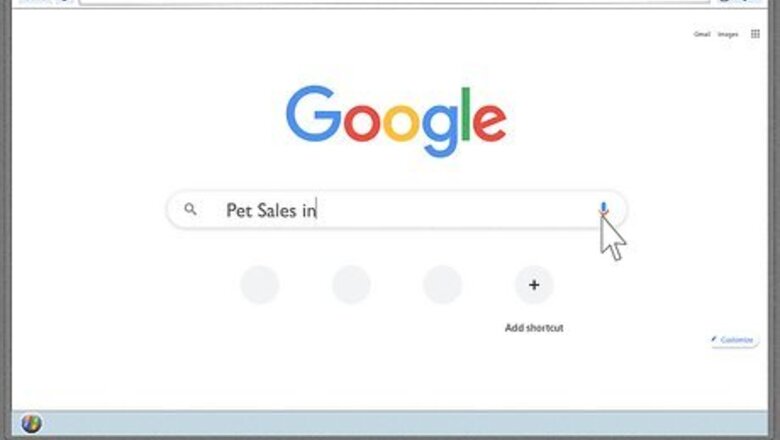
views
Advertising the Dog

Check your local laws for pet selling requirements. Many towns and cities regulate pet sales. Do an online search for "pet sales in" with the name of the city or town where you live and see what comes up. Look for an official government site that you can rely on. If your online search isn't turning up anything, talk to your vet—they likely have a good idea of the local laws or can connect you with someone who does. Some local laws require you to apply for a permit before you can sell an animal. Although there might be an exception if you're not a breeder and are only selling one dog, it's still worth looking into to make sure. Regulations might require you to include specific information in your ad or restrict places where a sale can be completed. All of this is good information to know beforehand!

Review the puppy or adoption contract if you signed one. If you adopted your dog from a rescue or bought it from a breeder, you might have been required to sign one of these contracts. Puppy and adoption contracts often require you to return the dog to the original breeder or rescue if it isn't a good fit for your home. If you have one of these contracts, read it carefully. There might be an age restriction on the requirement for you to return the dog. It's a good idea to contact the breeder or rescue where you got the dog if you signed a contract—regardless of what the specific text of the contract says. They might be willing to take the dog back and save you a lot of hassle.

Write down basic information about your dog. It's possible that you'll be making multiple advertisements, so it helps to have all of this information handy. Your local laws might require you to include specific information in your advertisement, but at a minimum, you'll need at least the following: Name Breed Age Sex Registration information or ID numbers, if applicable Health information Personality and temperament Training Requirements and limitations

Take pictures or make videos of your dog. Photos draw people's eyes to your advertisement and make them fall in love with your dog. Get your dog groomed before the photos so it looks its best. Then pick a background and atmosphere that showcases your dog's personality and what makes it unique. If you're planning to post advertisements online, such as on social media, videos help prospective buyers see a little of your dog's personality or any tricks it does. You can also show off how well-trained your dog is.

Make copies of the documentation you have for your dog. Any potential buyer will want to see your documentation and it can help you establish the price you've set for the dog. Include anything related to your dog, its background, and its life with you. This might include: Veterinary records (take your dog for a thorough check-up before rehoming it) Registration Microchip registration Training certificates Prizes or awards

Calculate the total price for the dog ahead of time. Add up any costs that you want to figure into the price, such as food, veterinary bills, or registration fees. Include everything so your potential buyers understand the costs upfront. Many scams start with one price, then keep requesting additional money for other things. A breakdown of these costs will also help potential buyers understand why you set the price how you did, so they'll be less inclined to haggle with you. For example, if you've set your price at $600, you might list $100 for food and supplies that will go with the dog, $350 for veterinary expenses to get the dog ready for adoption, and $150 for grooming expenses. As a service, you might also include information about how much you spend each month on food, supplies, care, and upkeep of the dog. This helps potential owners evaluate if they're financially able to care for the dog over the long term.
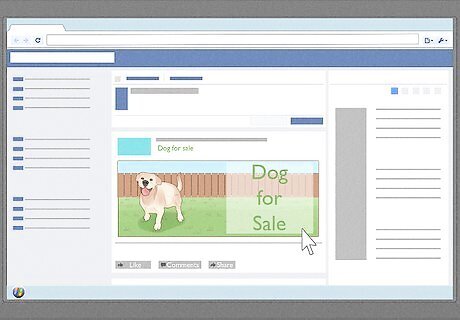
Make a post on your social media accounts. Social media platforms are a great way to get the word out that you want to sell a dog. Restrict your posts to your friends and followers (at least at first) so you can control who sees the post. A friend might ask you to make your post public so they can share it more widely. If they do, use your best judgment. You might want to remove some information that you wouldn't want to share with the general public. Talk to friends and family you know and trust—especially if you're trying to sell a dog that has been a beloved pet. You can be sure that they'll treat your dog well, so they should be your first choice to take it. If you're selling puppies from an unexpected litter, start advertising them and talking them up early—you can get new owners lined up for most of them before they're even weaned.
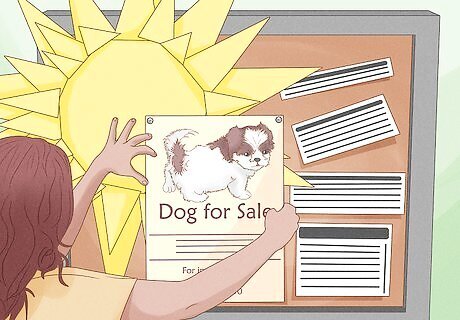
Post a flyer at local vet offices or pet supply stores. Many pet stores and vet offices have community bulletin boards where you can tell people about your dog. Include a photo along with information about your dog and a way to contact you. The benefit of these flyers is that they'll attract the attention of local people who are already animal lovers and likely already have pets. If your dog doesn't do well with other animals, though, this might not be the best option for you. To protect your privacy, create a free email address that you'll use for all inquiries about the dog. You can include that email address on your flyers without worry.

Put up an ad on an online marketplace as a last resort. There are many online marketplaces that host ads selling pets. The biggest problem with these marketplaces is that you have no control over who sees and responds to your ad. Because scams are prevalent, you have to use extreme caution. Before you use a commercial online marketplace, check the websites of local humane societies and shelters. Many have their own forums that are more secure than online marketplaces and cater to locals. There are online marketplaces where you can advertise litters of puppies, but the most secure ones are restricted to registered breeders. If you're not a registered breeder, you're better off selling your puppies locally.
Evaluating Prospective Buyers
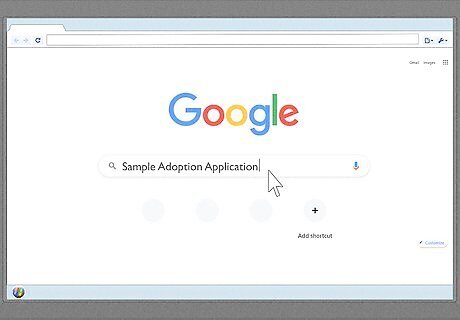
Make an application for prospective buyers to fill out. Search online for sample dog adoption applications—many shelters and breeder organizations offer these. You can use the sample as is or adapt it to better suit your needs. Think about the dog's needs and limitations and ask questions that will help you determine if the prospective buyer will be able to provide a good home for the dog. Here are some questions you might include: Have you owned a dog before? Do you currently own any dogs or other pets? If so, list them along with their age and breed/size. Where will the dog be when you aren't at home? Where will the dog be when you are at home? Do you have any children? If so, list each child and their age. Do you rent or own your home? If you rent, are pets allowed? Do you have a regular veterinarian?

Meet with prospective buyers a couple of times. If the prospective buyer is someone you don't know, meet them first in a public place without the dog. This gives you an opportunity to chat with them for a little while and get a feeling for the kind of person they are. You might also meet them at a park with the dog. This gives them an opportunity to meet the dog and play with it and you can see how they interact with the dog.

Visit prospective buyers at their home. Let the prospective buyer show you the space they have for the dog and how they imagine the dog spending an average day. You can talk to them about where the dog will be kept when they're not at home and how they'll interact with the dog when they are. If the prospective buyer has other pets or small children, you might want to take your dog on several visits before you finalize the sale. That way, both you and the prospective buyers can make sure everybody gets along.

Ask prospective buyers for a veterinary reference. If the prospective buyer currently has or previously had pets, a veterinary reference can help you better understand how they take care of the animals in their care. You'll also get a sense of the person's familiarity with dogs and ability to care for them. If the prospective buyer doesn't have a veterinary reference or tells you they don't feel comfortable giving you one, it's not necessarily a red flag—unless the person currently has pets. A prospective buyer who currently has pets and refuses to give you even the name and phone number of their veterinarian should give you pause. If you're selling an adult dog with potential health issues, that's definitely a red flag.
Finalizing the Sale
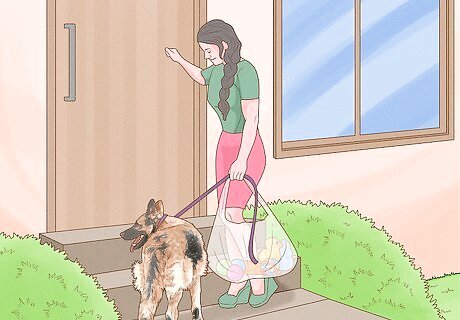
Transport your dog to its new home. It's usually best if you can take your dog to the buyer's home. That way, you can check out their setup and let them know if they need anything. You can also make sure the dog is happy and feels at home. Bring along the dog's toys and anything it's attached to, as well as any food and other supplies you still have. The dog will feel more at home if it has some familiar things with it.

Sign contracts transferring ownership of your dog. Written contracts are important to protect your interests, the buyer's interests, and the interests of the dog. Because animal law can be pretty specific, it's a good idea to have an attorney draft your contract for you or at least look over one you've prepared yourself. If money's tight, though, you can find plenty of sample contracts online that you can use. Make sure your contract includes requirements that the new owners comply with all local regulations regarding pet ownership, such as vaccinations and leash laws. If your dog is microchipped, include a clause about keeping it up to date. You might also include a clause in the contract that requires the new owners to return the dog to you if they find they can't take care of it. If your dog has a registered pedigree, you might be able to transfer ownership of that pedigree registration online. For example, the American Kennel Club (AKC) has an online transfer option for AKC-registered dogs.

Keep in contact with your dog's new owners. After the dog has moved to its new home, the owners might have questions for you from time to time. Let them know that they're welcome to call or email you if necessary. If you have a strong relationship with the dog, you might also encourage them to send you pictures or videos of how the dog is getting along in its new home. Let them know that you want to check up on the dog from time to time and see what they say. At a minimum, text or email after the first week or two just to make sure everything's going well and there aren't any concerns.

Make follow-up visits with the dog. If you get along well with the buyers, you might be able to still hang out with the dog on occasion. This can be a blessing if you were close to the dog because it means you don't have to completely say goodbye. For example, if you had to move to a place where dogs aren't allowed, you might offer to take the dog to the dog park once a week. That way, you still get to play with the dog even though it can't live with you anymore.




















Comments
0 comment